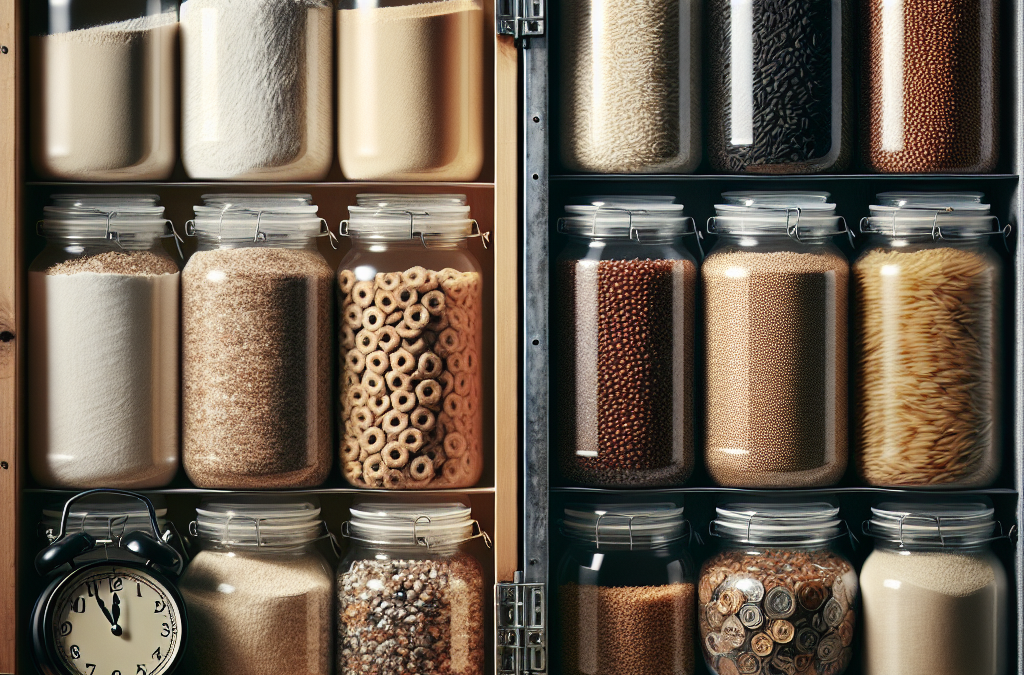The Basics of Flour and Grain Storage
Understanding Flour Types
When we talk about flour, we’re diving into a variety of types, each with its unique characteristics and storage needs. From all-purpose to cake flour, each flour has a different fat content and moisture level. For example, whole wheat flour has more oils and nutrients, which makes it more prone to spoilage compared to refined flours.
During my baking adventures, I’ve learned that understanding your flour types is crucial for quality results. I always keep a good stash of all-purpose flour on hand because it’s versatile. However, if you’re aiming for healthier options, whole grain or specialty flours like almond or coconut are great. Just keep in mind how they differ in terms of longevity!
Each flour type has unique attributes that affect how quickly it can go bad. By being mindful of the differences, we can store them effectively and ensure they last longer. Remember, fresher flour equals fresher baked goods!
The Essentials of Whole Grains
Whole grains, on the other hand, come packed with nutrients and fiber. They still contain the bran, germ, and endosperm, making them powerhouses for our diets. However, with that density of nutrition comes the downside of shorter shelf life due to the oils present in the germ.
From my experiences exploring different whole grains, I’ve often noticed that they can develop rancidity if stored improperly. For instance, brown rice and farro can last only so long, especially if left in warm or humid environments. It’s imperative to store whole grains in a cool, dry place if you want them to stand the test of time.
Knowing how to handle whole grains will keep your soups, stir-fries, and salads nutritious and delicious. Keeping them fresh means you’ll always be prepared for a wholesome meal.
Choosing the Right Storage Containers
Choosing the right container to store your flours and grains can make all the difference. I’ve made the mistake of using flimsy bags, and let me tell you, it wasn’t pretty! Resealable bags may be convenient, but they don’t provide the best protection from air and moisture.
Glass jars and airtight containers have become my go-to storage options. They keep air out and help maintain that lovely freshness. I love to label each container with the type of flour or grain and the date purchased, so I can keep track of what I have and what I need to use up.
By investing in good storage solutions, we create a favorable environment for the longevity of our flour and grains. Plus, they look pretty on the shelves, adding a bit of charm to the kitchen!
Understanding Shelf Life
Flour Shelf Life
The shelf life of flour typically ranges based on the type, with refined flours lasting longer than whole grain varieties. Regular all-purpose flour can sit comfortably for about a year, while whole wheat flour usually only stretches to roughly 6 months. If you’re like me and tend to buy in bulk, using oxygen absorbers can extend that time significantly.
Trust me, there’s nothing worse than reaching for flour and finding out it’s gone sour. I’ve invested in a vacuum sealer, and it’s been a game changer! It’s easy to store and keeps my flour fresher for much longer. I highly recommend trying this out if you’re a frequent baker!
Ultimately, knowing how long your flour lasts helps you plan better. Remember, freshness contributes to the overall flavor and quality of your baked goods!
Whole Grain Shelf Life
Whole grains, being high in healthy fats, tend to spoil faster. Most will last about 3 to 6 months when stored correctly; however, some can extend that lifespan with proper methods. For instance, keeping whole grains in the fridge can help prevent rancidity, which I’ve found makes a significant difference.
A classic example from my pantry is quinoa, a personal favorite. Left at room temperature, it’s not going to last forever, but popped into the fridge, I can extend its freshness and use it in various dishes throughout the month without any issues.
Remember, the nutritional aspects play a major role in how long grains last, so considering how you store them is just as essential as the grain choice itself. It’s all about creating that perfect balance!
Signs of Spoilage
Knowing the signs of spoilage for both flour and grains is crucial. A change in smell is often the first clue that something’s off. Flour can develop a sour or rancid odor over time, which I’ve unfortunately noticed more than once. If your flour starts to smell off, it’s likely time for it to go.
For grains, look for discoloration or insect activity—those little critters love to invade a poorly stored pantry! I’ve always made it a habit to check for any irregularities when using up my stored goods. If anything seems odd, it’s better to be safe than sorry.
Get Whole Wheat Flour, Grains and Milling Supplies – CLICK HERE
Keeping everything tidy and organized allows you to have a full view of your stock. By being vigilant about signs of spoilage, we can save ourselves from wasting food and preserve our culinary adventures!
Practical Storage Techniques
Freezing for Longevity
If you’re diving into long-term storage solutions, freezing can be an excellent option! I’ve taken to storing larger quantities of flour and grains in the freezer. Believe me, it’s a great way to stave off spoilage. Freezing essentially pauses the aging process.
When I need a bit of flour or some whole grain for a recipe, I just take out what I need and let it come to room temperature before using it. Simple, right? This method has boosted my confidence when it comes to buying in bulk and tackling recipes!
Freezing also prevents the growth of pests, which can be quite the nuisance. So if you like to stock up or shop in bulk, give freezing a try—it’ll definitely pay off.
Proper Rotation of Stocks
Something that I can’t emphasize enough is the importance of rotating your stock. The first in is the first out, folks! I always am conscious of what I need to use first and make it a habit to check dates regularly.
Having a designated area in my pantry for older flour can help me keep tabs on them. It’s such a simple practice but can really transform your storage organization and ultimately reduce waste.
If you’ve ever discovered an ancient bag of flour hiding in the back of your pantry, you know the value of rotation. It’s all about being proactive rather than reactive!
Keeping it Cool and Dry
Lastly, the environment in which we store our flours and grains can hugely affect their shelf life. Keeping them cool and dry is crucial! I always aim for a dark place in the pantry away from the stove or oven where heat can creep in.
Humidity is another big factor—too much can lead to clumps and mold. I often use silica gel packets to absorb any excess moisture in my containers, which has helped keep things fresh. It might seem like a hassle, but the results are worth it!
By constantly working to maintain the right conditions, our flours and grains stand a fighting chance against spoilage. It’s such a little effort with significant gains!
Conclusion
In summation, whether you’re a baking aficionado or just someone who loves cooking healthy meals, being aware of how to properly store flours and whole grains will give you the upper hand. From understanding the basics to keeping everything fresh, you use your ingredients at their peak quality. Let’s keep enjoying those home-baked cookies and hearty grain bowls without worrying about spoilage!
FAQ
1. How can I tell if my flour has gone bad?
The best indicators are a change in smell or the presence of discoloration or clumps. If it smells sour or rancid, it’s best to discard it.
2. How long do whole grains last compared to flour?
Whole grains generally last between 3 to 6 months depending on how they’re stored, while all-purpose flour can last up to a year.
3. Can I freeze flour and grains for later use?
Absolutely! Freezing them can extend their shelf life significantly. Just make sure to bring them to room temperature before using.
4. What’s the best way to store flours?
Airtight containers or glass jars stored in a cool, dry place are ideal for keeping flour fresh longer.
5. Is there a way to prevent pests in my pantry?
Keeping your pantry clean and inspecting your flour and grains regularly is important. Consider using airtight containers and freezing to prevent pest infestations.
Get Whole Wheat Flour, Grains and Milling Supplies – CLICK HERE
Related Content
Auto Amazon Links: No products found.





